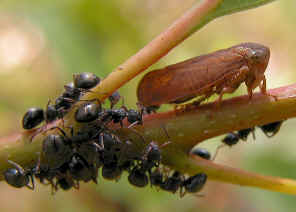- This page contains pictures and information about Froghoppers, Leafhoppers
and Treehoppers that we found in the Brisbane area, Queensland, Australia.
-
 - Leafhopper Nymphs
-
- All Froghoppers and leafhoppers are sapsuckers which feed on the
leaves, twigs, branches and/or trunk of the host trees. They insert
their needle-like stylets into plant tissue to feed.
-
- Froghoppers and leafhoppers lay eggs in plant tissue.
-



-
- Nymphs resemble adults although lacking wings. They feed on the same host
plants with adults. There are five nymphal instars stages.
-
- Froghoppers and leafhoppers have the most
aerodynamic-shaped body in the insect world. They are shaped by evolution.
They have thicker forewings known as tegmina which serve to protect when the
insects are at rest. All
of them are strong jumpers. Most nymphs can jump as well. When jump, they have the highest moving speed in the
insect world. Most ambush predators do not target at them because of their
high speed of escape. Some other insects even mimic
treehoppers to cheat predators.
Classification :
Superfamily CERCOPOIDEA - Froghoppers and Spittlebugs
Their nymphs produce 'spittle' clinging to the stems of shrubs or small
trees to reduce the risk of dehydration or to deter parasites. Those spittle
is sometimes known as cuckoo-spit. When carefully removed those
'spittle', we saw an insect nymph hiding inside.
Insects in this group are commonly known as Tube Spittlebugs. Their nymphs build and
live in calcareous tubes attached to stems of food plants. The nymphs
immersed in their liquid excretions. Their host plants are usually Eucalypts. Adults are usually greenish- yellow or black in colours.
They are small, plants feeding insects ranging in colour from green,
through yellow-green to brown. They can be found on tree trunks, stems and
leaves. They feed by sucking the sap of plants. All of them jump, so their
name hoppers. Some of their adults are active flyer.
Members in this family have the enlarged pronotum extending back over
the abdomen between wings, which gives them the bizarre looking body shape.
Many species also have the pronotum extending forward so that they are
horned. Some may mimic thorns on their host plant.
- Reference and links:
- 1. Insects
of Australia, CSIRO, Division of Entomology, Melbourne University
Press, 2nd Edition 1991, pp 474.
- 2. Insects of Australia and New Zealand - R. J. Tillyard, Angus &
Robertson, Ltd, Sydney, 1926, p165.
- 3. Identification
Keys and Checklists for the leafhoppers, planthoppers and their
relatives occurring in Australia and New Zealand (Hemiptera:
Auchenorrhyncha). Fletcher, M.J. and
Larivière, M.-C. (2001 and updates).
- 4. Auchenorrhyncha keys - Fletcher, M.J. (2009 and updates). Identification keys and checklists for the leafhoppers, planthoppers and their relatives occurring in Australia and neighbouring areas (Hemiptera: Auchenorrhyncha).
- 5. The leafhoppers and froghoppers of Australia and New Zealand (Homoptera: Cicadelloidea and Cercopoidea) - J W Evans, Australian Museum, 1966.
- 6. Northern
Territory Insects, A Comprehensive Guide CD - Graham Brown, 2009.
- 7. Suborder AUCHENORRHYNCHA - Australian Biological Resources Study, Department of the Environment and Heritage.
Back to top
[ Cercopoidea ] [ Membracoidea (Cicadelloidea) ] [ Other Hoppers and Unidentified Hoppers ]
|